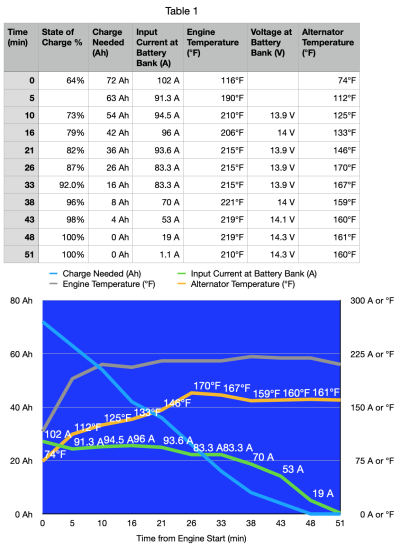Ok, so I took some measurements this morning. Here are the details:
2017 model year Dodge Promaster, 220A alternator. 2.9:1 pully ratio. Expected output (from spec curve) at engine 750 RPM (2175 RPM alt): 155.8A
Very cloudy day, quite dark out but muggy. I ran the AC for about an hour to lower drain the battery (not hot enough to run at 100% duty cycle, so it only got it down to about 64% charge = 72Ah deficit).
Battery bank is 2 x 100Ah Battleborn LiFePO4 batteries. Current measurement made with Victron 702 BMV measuring at the battery bank (e.g. does not measure chassis load or house load, only current flowing in or out of the battery bank).
Before starting the engine I see the following:
Current flow at battery: +1.1A (from solar)
Solar output: +1.3A (e.g. there is about 0.2A draw from house load)
Ambient Temperature: 71°F (from dash readout)
Alternator Temperature 74°F (from non-contact spot reading at metal alternator body near the front of the alternator by the pulley. This location was used for all measurements. It is not fully reflective of the alternator temperature in the short-term because the diodes are located in the back which I could not reach. The front is also where the cooling fan inside the alternator is located.)
All chassis accessories turned off (no AC, no radio, no headlights)
At engine startup I saw the following:
- Current into battery 102A
- Engine RPM 750 @ idle (which is where I kept it for the full measurement cycle)
- No increase in current when engine RP raised to 2800 and held there for 30 sec. (e.g. something else is limiting the current input to the battery bank).
See the chart for my full measurement results as the alternator brought the battery from 64% charged to 100% charged.
Observation and Notes:
- I did not see the 120A input I have seen in the past. Theory 1 - perhaps it was combined input with my solar panels? They put out about 19.5A in full sunlight. Theory 2 - I had to move the RV up on ramps so I could reach the alternator, perhaps the 3 min of running lowered the current before I started the measurement cycle.
- The current drop over time appears to be entirely driven by the battery's ability to accept charge. The first significant decline happens when the SOC
reaches 96%.
- Turning on the AC with fan on high dropped the output from around 92A to 70A. The radio made no appreciative difference. I suspect my previous observations about Current drop over time were more driven by chassis and house load (inverter running the fridge / TV & DVD player on / AC on medium-high is typical for me).This would indicate that with all of those loads I really was at the alternator max output. Take this observation with a grain of sand, I didn't test it exhaustively or carefully.
- When the cooling fan on the engine cycled on it dropped the current by about 20A, but the output would climb back up again to around 92A. This seems to indicate the 92A is not the alternator output limit. Again, take this as tentative, however more reliable than the previous observation as the cooling fan ran for much of the test.
- When I stretched I could get a further back on the alternator and read temps from closer to the back. They were consistently higher, but I never saw a reading over 195°F.



